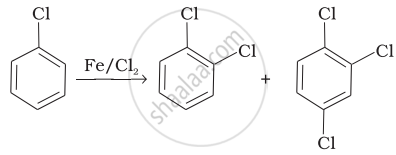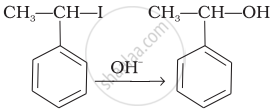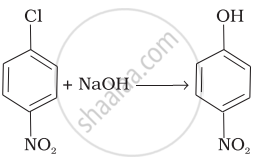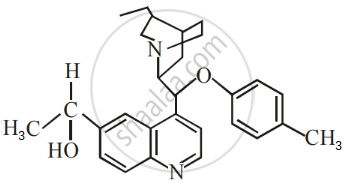Advertisements
Advertisements
प्रश्न
The treatment of alkyl chlorides with aqueous KOH leads to the formation of alcohols but in the presence of alcoholic KOH, alkenes are major products. Explain.
उत्तर १
In an aqueous solution, KOH almost completely ionizes to give OH– ion, a strong nucleophile and reacts with alkyl halides to form alcohols. In an aqueous solution, OH– ions are highly hydrated. This reduces the basic character of OH– ions, due to which they fail to separate hydrogen atoms from the β-carbon of alkyl halide and cannot form an alkene.
On the other hand, alcoholic solution of KOH contains alkoxide (RO–) ions which, being a stronger base than OH–, easily remove HCl molecule from alkyl chloride to form alkene.
उत्तर २
Simple nucleophilic substitution occurs when alkyl chlorides react with aqueous KOH to form alcohols.
\[\ce{CH3 - CH2 - Cl + KOH ->[H2O]CH3 - CH2 - OH + KCl}\]
When aqueous KOH is substituted with alcoholic KOH, HCI is eliminated from an alkyl halide, resulting in the formation of alkenes instead of alcohols.
\[\ce{CH3 - CH2Cl + KOH->[EtOH] CH2 = CH2}\]
This can be explained by the size of the nucleophile in both reactions. In an aqueous medium, the \[\ce{N\overset{Θ}{u}}\] is \[\ce{\overset{Θ}{O}H}\] which is small, whereas in an alcoholic medium, the \[\ce{N\overset{Θ}{u}}\] is \[\ce{C2H^Θ5}\] is bulky.
The bulky \[\ce{N\overset{Θ}{u}}\] always find it easier to abstract a proton rather than attack a tetravalent carbon and form a substitution product.

If C2H5OΘ attacks a carbon-carrying halogen, steric repulsions can delay the attack and prevent substitution.
Notes
Students can refer to the provided solutions based on their preferred marks.
APPEARS IN
संबंधित प्रश्न
Discuss the mechanism of alkaline hydrolysis of bromomethane.
Write the structure of an isomer of compound C4H9Br which is most reactive towards SN1 reaction
Out of  , which is more reactive towards SN1 reaction and why?
, which is more reactive towards SN1 reaction and why?
Write the structure of the major organic product in the following reaction:
\[\ce{CH3CH(Br)CH2CH3 + NaOH ->[water]}\]
Arrange the compounds of the following set in order of reactivity towards SN2 displacement:
1-Bromo-3-methylbutane, 2-Bromo-2-methylbutane, 2-Bromo-3-methylbutane
Arrange the compounds of the following set in order of reactivity towards SN2 displacement:
1-Bromobutane, 1-Bromo-2, 2-dimethylpropane, 1-Bromo-2-methylbutane, 1-Bromo-3-methylbutane
What happens when chlorobenzene is subjected to hydrolysis?
What happens when ethyl chloride is treated with aqueous KOH?
C–Cl bond length in chlorobenzene is shorter than C–Cl bond length in CH3–Cl.
What is the action of the following on ethyl bromide?
moist silver oxide
In the reaction, \[\ce{R - X + NaOR' -> ROR’ + X}\] ( – ve ion). The main product formed is:
Isopropyl chloride undergoes hydrolysis by:
Which of the following is a chiral compound?
How do polar solvents help in the first step in SN1 mechanism?
Cyanide ion acts as an ambident nucleophile. From which end it acts as a stronger nucleophile in aqueous medium? Give reason for your answer.
Match the reactions given in Column I with the types of reactions given in Column II.
| Column I | Column II | |
| (i) |  |
(a) Nucleophilic aromatic substitution |
| (ii) | \[\begin{array}{cc} \ce{CH3 - CH = CH2 + HBr -> CH3 - CH - CH3}\\ \phantom{............................}|\phantom{}\\ \phantom{.............................}\ce{Br}\phantom{} \end{array}\] |
(b) Electrophilic aromatic substitution |
| (iii) |  |
(c) Saytzeff elimination |
| (iv) |  |
(d) Electrophilic addition |
| (v) | \[\begin{array}{cc} \ce{CH3 CH2 CH CH3 ->[alc.KOH] CH3 CH = CH CH3}\\ \phantom{}|\phantom{..........................}\\ \phantom{}\ce{Br}\phantom{........................} \end{array}\] |
(e) Nucleophilic substitution (SN1) |
The number of chiral carbons present in the molecule given below is ______.

Optical activity of an enantiomeric mixture is +12.6° and the specific rotation of (+) isomer is +30°. The optical purity is ______ %.
